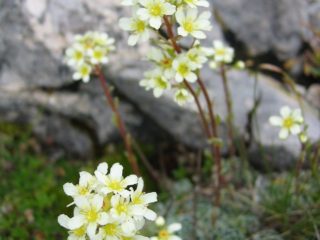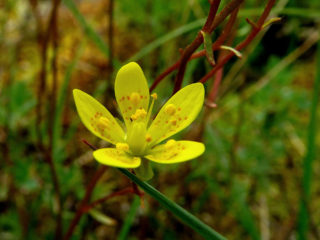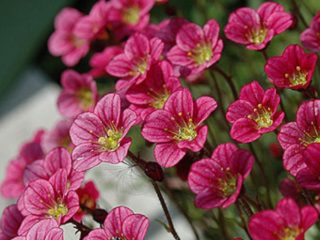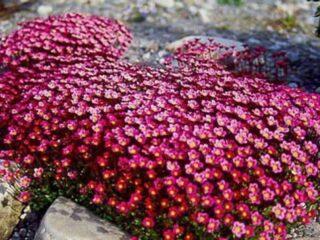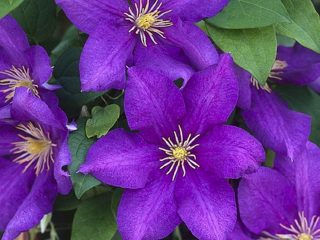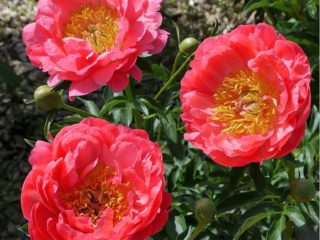Content
Shadow saxifrage (Saxifraga umbrosa) is an evergreen ground cover with high frost resistance. The plant is ideal for filling empty space in areas where other garden crops would not normally survive. Undemandingness to care and soil composition allows you to grow shady saxifrage even for gardeners who do not have much experience. But in order for the plant to create a lush “living carpet” on the soil surface, you need to adhere to certain rules.
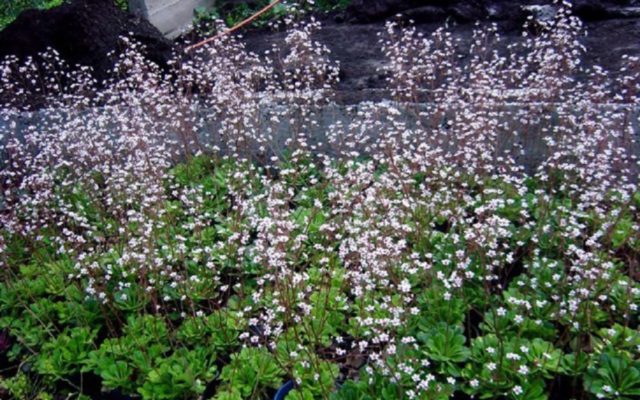
Shadow saxifrage gets along well with various trees and shrubs
Description of shady saxifrage
This culture belongs to the Saxifraga family. The height of the plant barely reaches 8-10 cm. It forms numerous rosettes, which are connected to each other with the help of underground shoots and thus fill the entire allotted space.
The leaves of Saxifraga are shadowy oval in shape, small and dense.The plates are dark green in color and reach 5 cm in length. They are concentrated at the base of the plant and form a basal rosette. The edges of the leaves are uneven, and there are purple stains on the reverse side.
During the flowering period, the plant forms thin paniculate peduncles up to 15 cm high. They rise above the foliage and can be white or pink in color with a contrasting purple center. The flowers of Saxifraga umbra (photo below) are simple, consist of 5 petals, up to 1 cm in diameter. In the center, when the buds are fully opened, you can see 8-10 stamens.
The fruits of Saxifraga are shady in the form of small oblong boxes in which numerous small black seeds ripen.
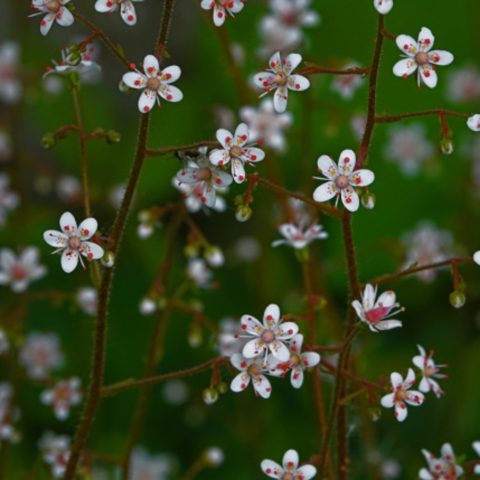
During the flowering period, plantings look like an exquisite openwork “carpet”
Distribution area
Shadow saxifrage can be found in nature in Western Europe. She prefers to settle in shady places on mountain slopes.
The plant is characterized by high hardiness and can grow in any crevices, which is why it got its name. In rare cases, shadow saxifrage can be found in the steppe, on forest edges and on roadsides.
The best varieties
Thanks to the selection carried out, new types of crops were obtained based on the wild form of the plant. Modern varieties are highly decorative, which allows expanding the scope of their application in landscape design.
Variegata
The variety is distinguished by wide spatulate green leaves with yellow stripes.The height of the plant does not exceed 7 cm, but during the flowering period it reaches 20-30 cm. The flowers of this variety are white with a convex pink center, the color of which matches the peduncles.
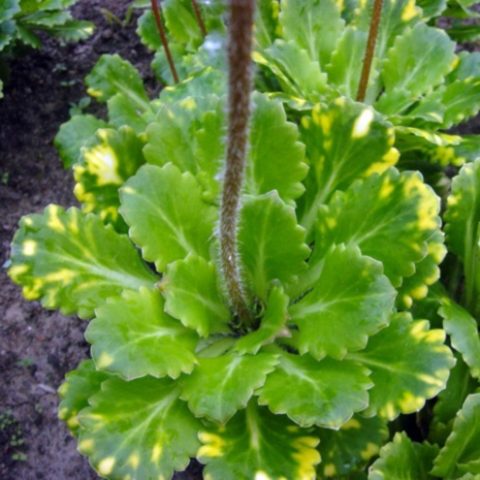
The diameter of the leaf rosettes of the shadow saxifrage Variegata is 8 cm
Aureovariegata
This variety is in many ways similar to the previous one, only on its leaves there are not yellow stripes, but spots. Flowering occurs in the second decade of June and lasts 4 weeks. Shadow saxifrage Aureovariegata produces simple white flowers with a purple center.
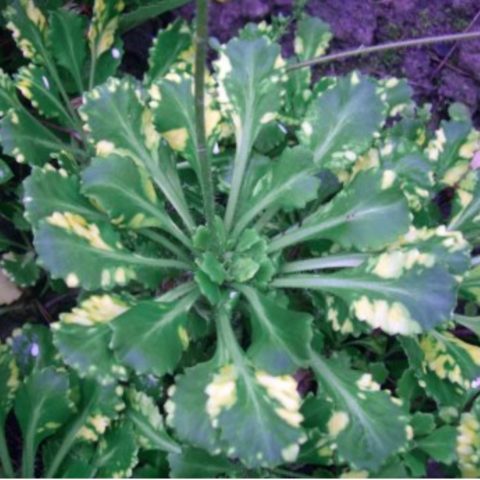
The height of the plant and the diameter of the rosettes of this variety reaches 8 cm
Aureopunctata
This variety is distinguished by dark green leaves, on which light spots or dots are randomly located. Shadow saxifrage Aureopunctata produces small buds that turn light pink when fully opened. The height of the plant is 7 cm, and the peduncles are 25 cm.
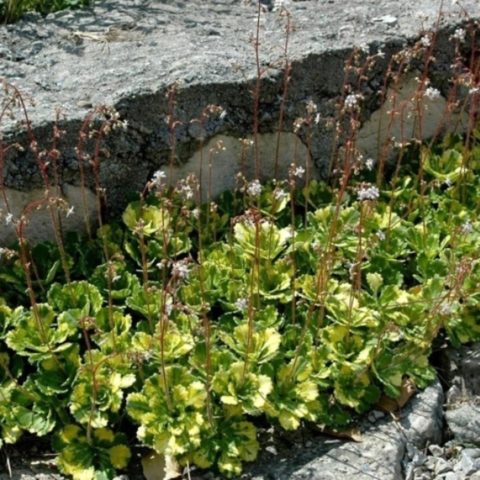
The flowering period of the Aureopunctata variety begins in the first ten days of June
Elliot's Variety
This type of saxifrage is characterized by small, dense leaves of a dark green color. There are small light spots on the surface of the plates. The diameter of the rosettes of the saxifrage Elliotis Variety does not exceed 6 cm. The height of the plant reaches 5 cm.
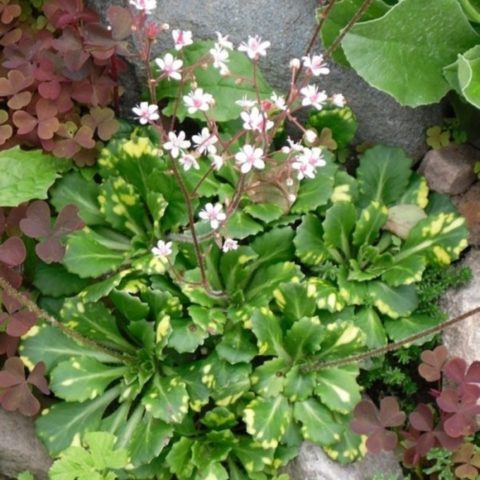
This variety has white flowers with a slight pink tint.
Primulodis
The variety is characterized by small, smooth, light green foliage. The height of the saxifrage shadow Primulodis (Primuloides) does not exceed 7 cm, and the diameter of the basal rosettes is 6 cm. The flowers are single, white, located alternately on peduncles.
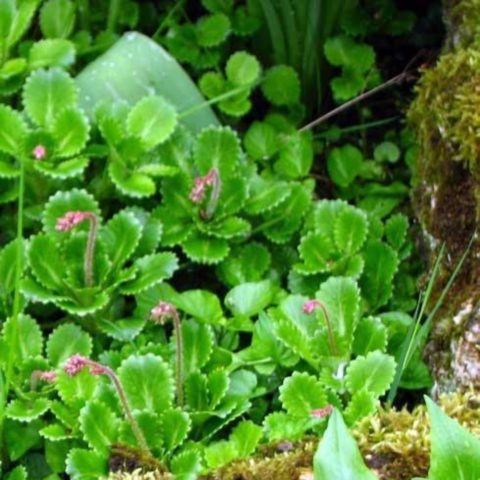
Shadow saxifrage Primulodis goes well with any garden crops
Application in landscape design
This ground cover can grow in any shady places in the garden where other crops cannot survive.
Landscape designers recommend using shadow saxifrage:
- for designing rocky gardens;
- for landscaping artificial reservoirs;
- for framing paths;
- to fill the space under trees and shrubs;
- for creating alpine slides, mixborders, rockeries.
The ground cover can be combined with other low-growing garden crops, which can successfully complement each other. As neighbors you can use marsh irises, muscari, and decorated gentian.
Reproduction methods
To obtain new saxifrage seedlings, the method of dividing the bush is used. The procedure can be carried out after flowering, but no later than the end of August. Delays may result in plants not having time to take root before frost and dying in the winter. The seed propagation method is not used for this type of crop.
The day before dividing, the ground cover should be watered moderately. This will allow the procedure to be carried out with minimal stress on the plant. The next day, you need to carefully dig up rosettes of shadow saxifrage using a knife and separate them from each other.
After this, the seedlings should be immediately planted in a permanent place and watered with a solution of any root former. In order for the plants to adapt faster, they must be covered with a transparent cap in the first week.
Planting and caring for shadow saxifrage
For this ground cover, you need to choose the right place in the garden and plant it. Otherwise, it will not be possible to grow a “living carpet” on the site. Therefore, before you start this plant in the garden, you should study the basic requirements of the culture.
Recommended timing
It is necessary to plant shadow saxifrage in a permanent place when the soil is sufficiently warm and the weather is warm with a temperature of at least 15-17 degrees, regardless of the time of day. The optimal period for planting is the end of May - beginning of June.
Site selection and preparation
For shady saxifrage, you should choose shaded, elevated areas where melt water will not stagnate in winter, otherwise the plant will die. Therefore, it can be planted at the base of trees or shrubs, as well as on the shady side of paths, gazebos, and in secluded corners of the garden.
The ground cover is undemanding in terms of soil composition, but does not tolerate prolonged stagnation of moisture, so it needs to be provided with good drainage. To do this, you should add lime, sand, and fine gravel to the soil in advance, 3 kg per square meter. m. All this should be thoroughly mixed with the ground. You also need to water the soil a day before planting.
Landing algorithm
It is recommended to plant saxifrage seedlings in cloudy weather or in the evening. This will allow the plants to quickly adapt to the new location.
Algorithm of actions:
- Prepare wells at a distance of 10 cm from each other.
- Make a small elevation in the center of each of them.
- Place the seedling on it, carefully straighten the roots.
- Sprinkle them with soil and fill all the voids.
- Compact the surface and lightly water along the edge of the planting hole.
Watering and fertilizing schedule
At the initial stage, it is necessary to constantly monitor soil moisture and irrigate in the absence of rain. To do this, use settled water at a temperature of +20 degrees. Moistening should be done every time the soil dries to a depth of 2-3 cm.
During periods of drought, it is recommended to mulch shady saxifrage plantings with a layer of peat 1-2 cm thick. This will reduce the evaporation of moisture from the soil and prevent drying out of the root system.
To feed this ground cover, only mineral fertilizers can be used. They should be applied for the first time in the spring during the growth of new leaves. At this time, you can use nitroammophoska. In the future, fertilizing should be done before and after flowering. During these periods, use phosphorus-potassium mixtures.
Trimming
To preserve the decorative appearance of the plant throughout the season, it is necessary to promptly remove faded flower stalks. Also in the spring, you can trim off damaged leaf rosettes and plant new ones in their place.
Preparing for winter
Shadow saxifrage has high frost resistance. The plant does not suffer from temperatures dropping to -30 degrees. But to preserve the appearance of the rosettes, it is necessary to sprinkle the ground cover plantings with a layer of fallen leaves upon the arrival of the first stable frosts.
Pests and diseases
If the growing conditions are inappropriate, the plant’s immunity decreases. Therefore, shadow saxifrage can suffer from fungal diseases and pests.To avoid this, it is necessary to periodically inspect the plantings and carry out treatment at the first signs of damage.
Possible problems:
- Spider mite. The pest is activated at low humidity and high temperature. The lesion can be recognized by the depressed appearance of the plant and the thin apical web. It is recommended to use Actellik for fighting.
- Aphid. A sucking plant parasite that feeds on the sap of Saxifraga leaves. It is not difficult to detect, since it forms entire colonies on the underside of the leaves. If it spreads massively, the plant may die. For destruction, “Confidor Extra” should be used.
- Root rot. The disease develops with prolonged stagnation of moisture in the soil. This leads to the withering of the above-ground part, as the root ceases to function. Diseased shadow saxifrages cannot be treated, so they need to be dug up. And, in order to prevent further spread, the soil should be watered with Previkur Energy
- Powdery mildew. The disease begins to progress at high humidity and temperature. It can be recognized by a white coating on the leaves, which later turns brown. As a result, the affected areas dry out. For treatment, it is recommended to use the drug “Topaz”, “Skor”.
Conclusion
Saxifraga shady is an undemanding ground cover crop that will help disguise unsightly places on the site. In this case, the plant does not require special care. Therefore, its popularity is growing every year, because few garden crops combine similar qualities.



